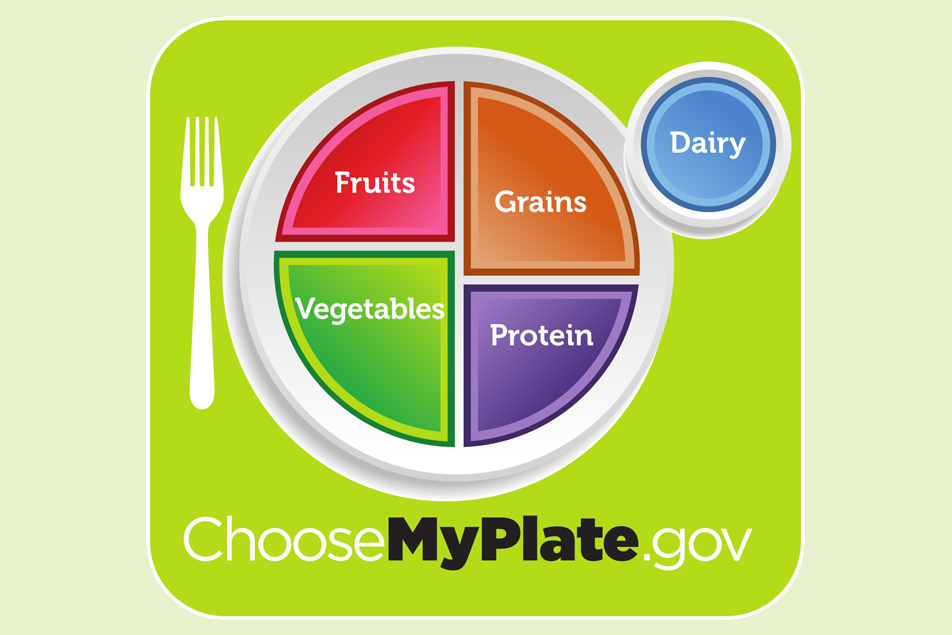
This post was written by Megan Bragiel, RDN, and Jordan Santilli, RDN, Parkview Health.
The food groups
MyPlate is a healthy way of eating that includes foods from all the food groups, including fruits, vegetables, grains, protein and dairy. It’s important to include a variety of these different types of foods in your meals, snacks and beverages each day. You should choose food and beverage options that are lower in sodium, saturated fat and sugar.

Fruits: Focus on eating the whole fruit to help get some extra fiber in each day. Include fruit with breakfast by adding sliced bananas, apples or berries to your cereal, yogurt, pancakes or oatmeal.
Vegetables: Wash and chop up veggies after you buy them to help keep an easy and nutritious snack on hand. Add vegetables to soups, salads or stir fry, or toss them on a sheet pan with some olive oil and roast them in the oven for a quick side dish.
Grains: Try to make half of your grains whole grains, such as whole grain cereal, pita, tortillas, bread or rolls. Add some different types of grains into your recipes that you may not have tried before, such as quinoa, amaranth, buckwheat, barley, cous cous, farro or wild rice.
Protein: Try to include fish or seafood once or twice a week to add in some heart-healthy omega-3 fatty acids. Include some meatless meals that still contain protein for a change, such as lentil soup, black bean burgers, grilled tofu, vegetable wrap with hummus, or adding nut butters to recipes.
Dairy: Milk is a good source of protein and calcium. You can add it to oatmeal, soups or smoothies. Choose unsweetened versions of lactose-free or soy milk.
Hydration
Our bodies need water in order to prevent infections, deliver nutrients to cells, help our organs function properly, hydrate our muscles and regulate our body temperature. Additionally, being hydrated can improve our mood, sleep quality and memory.
You should aim for at least eight eight-ounce glasses of water each day, unless your doctor has told you otherwise. Sodas, coffee, iced tea and energy drinks contain caffeine that acts as a diuretic in your body. This means that you are pulling a little extra fluid from your body when you drink these beverages, so be sure to drink enough water throughout the day.
Limit the consumption of sugary beverages such as fruit juice, soda, fruit punch, sports drinks and energy drinks. Some fruits contain a good amount of water, such as grapefruit, watermelon, grapes, pineapple and cantaloupe. You can also add some sliced-up fruit to water as a flavorful and healthful alternative to sugary beverages.
Mindful eating
Shifting to a mindfulness-based approach to eating means avoiding distractions while eating and taking time to enjoy your food. While many diet trends tend to set specific guidelines and limitations on the foods we eat, the idea of mindful eating is intended to be more focused on the process and experience of choosing the foods we eat. You may see that practicing mindful eating can help support behavior change that may be more realistic to sustain long term, in comparison to a more outcome-driven diet.
Here are a few tips and tricks to help you start practicing more mindfulness at mealtime:
- Begin with a shopping list – Plan for your grocery trip by making a shopping list and sticking to it as much as possible. This can help bring more value to your food items and help to limit impulse buying.
- Sit down – Limit eating on the go as much as possible. Make an effort to give yourself time to sit down, relax and reflect on your food and how you are feeling before starting to eat.
- Eat slowly – This will help you appreciate the flavors, tastes and smells of your meal. Try putting down your utensils and taking smaller bites to help with this.
- Chew thoroughly – Be mindful that you are chewing each bite thoroughly before swallowing your food. The idea behind this is to give your gut and brain time to communicate with each other, which in turn may help prevent overeating.
- Limit distractions – Give yourself a quiet environment free of electronic devices and background noise that may distract you from the experience of enjoying your food.
Reading labels
There are many reasons to look at the nutrition label of the foods that we eat. A great way to start making more informed food choices when it comes to meals and snacks is to simply compare foods based on the nutrition facts panel.
Did you know that the nutrition facts panel on packaged foods was recently revised? This was done to make it easier for users to gather the nutrition information of the foods we eat more efficiently and effectively. Below is a example from the FDA showing the new look. This should be helpful guide when it comes to making more nutritious choices at meals.

Sources



